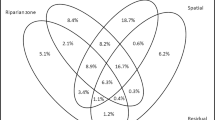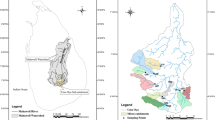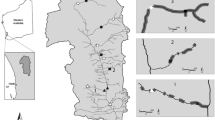Abstract
Riparian land use remains one of the most significant impacts on stream ecosystems. This study focuses on the relationship between stream ecosystems and riparian land use in headwater regions. Four riparian land types including forest, grassland, farmland, and residential land were examined to reveal the correlation between stream water and fish communities in headwater streams of the Taizi River in north-eastern China. Four land types along riparian of 3 km in length were evaluated at 25, 50, 100, 200 and 500 m widths, respectively. Generally, the results found a significant relationship between riparian land uses and stream water quality. Grassland was positively correlated with water quality parameters (conductivity and total dissolved solids) at scales from 100 to 500 m riparian width. Farmland and residential land was negatively correlated with water quality parameters at scales from 25 to 500 m and from 50 to 200 m riparian widths, respectively. Although the riparian forest is important for maintaining habitat diversity and fish communities, the results found that only fish communities were significantly correlated with the proportion of riparian farmland. Farmland had a positive correlation with individual fish abundance within a riparian corridor of 25 to 50 m, but a negative correlation with fish diversity metrics from 25 to 100 m. This study indicates that effective riparian management can improve water quality and fish communities in headwater streams.
Similar content being viewed by others
References
Wang L, Lyons J, Kanehl P, Gatti R. Influences of watershed land use on habitat quality and biotic integrity in Wisconsin stream. Fisheries (Bethesda, Md.), 1997, 22(6): 6–12
Lammert M, Allan J D. Environmental auditing: assessing biotic integrity of streams: effects of scale in measuring the influence of land use/cover and habitat structure on fish and macroinvertebrates. Environmental Management, 1999, 23(2): 257–270
Allan J D. Landscapes and riverscapes: the influence of land use on stream ecosystems. Annual Review of Ecology Evolution and Systematics, 2004, 35(1): 257–284
Jones E B D, Helfman G S, Harper J O, Bolstad P V. Effects of riparian forest removal on fish assemblages in southern Appalachian streams. Conservation Biology, 1999, 13(6): 1454–1465
Wright J P, Flecker A S. Deforesting the riverscape: the effects of wood on fish diversity in a Venezuelan piedmont stream. Biological Conservation, 2004, 120(3): 443–451
Diamond J M, Bressler D W, Serveiss V B. Assessing relationships between human land uses and the decline of native mussels, fish, and macroinvertebrates in the Clinch and Powell River watershed, USA. Environmental toxicology and chemistry / SETAC, 2002, 21(6): 1147–1155
Meyer J L, Strayer D L, Wallace J B, Eggert S L, Helfman G S, Leonard N E. The contribution of headwater streams to biodiversity in river networks. Journal of the American Water Resources Association, 2007, 43(1): 86–103
Richardson J S, Danehy R J. A synthesis of the ecology of headwater streams and their riparian zones in temperate forests. Forest Science, 2007, 53(2): 131–147
Wipfli M S, Richardson J S, Naiman R J. Ecological linkages between headwaters and downstream ecosystems: transport of organic matter, invertebrates, and wood down headwater channels. Journal of the American Water Resources Association, 2007, 43(1): 72–85
Allan J D, Erickson D L, Fay J. The influence of catchment land use on stream integrity across multiple spatial scales. Freshwater Biology, 1997, 37(1): 149–161
Wang L, Lyons J, Kanehl P, Bannerman R. Impacts of urbanization on stream habitat and fish across multiple spatial scales. Environmental Management, 2001, 28(2): 255–266
Snelder T H, Biggs B J F. Multiscale river environment classification for water resources management. Journal of the American Water Resources Association, 2002, 38(5): 1225–1239
Greenwood M J, Harding J S, Niyogi D K, McIntosh A R. Improving the effectiveness of riparian management for aquatic invertebrates in a degraded agricultural landscape: stream size and land-use legacies. Journal of Applied Ecology, 2012, 49(1): 213–222
Osborne L L, Kovacic D A. Riparian vegetated buffer strips in water-quality restoration and stream management. Freshwater Biology, 1993, 29(2): 243–258
Gregory S V, Swanson F J, McKee W A, Cummins K W. An ecosystem perspective of riparian zones: focus on links between land and water. Bioscience, 1991, 41(8): 540–551
Hughes R M, Howlin S, Kaufmann P R. A biointegrity index (IBI) for coldwater streams of western Oregon and Washington. Transactions of the American Fisheries Society, 2004, 133(6): 1497–1515
Paul M J, Meyer J L. Streams in the urban landscape. Annual Review of Ecology Evolution and Systematics, 2001, 32(1): 333–365
Harvey B C. Susceptibility of young-of-the-year fishes to downstream displacement by flooding. Transactions of the American Fisheries Society, 1987, 116(6): 851–855
Regetz J. Landscape-level constraints on recruitment of Chinook salmon (Oncorhynchus tshawytscha) in the Columbia River Basin, USA. Aquatic Conservation, 2003, 13(1): 35–49
Teresa F B, Romero R M, Casatti L, Sabino J. Fish as indicators of disturbance in streams used for snorkeling activities in a tourist region. Environmental Management, 2011, 47(5): 960–968
Cañas CM, Pine WE III. Documentation of the temporal and spatial patterns of Pimelodidae catfish spawning and larvae dispersion in the madre de Dios River (Peru): insights for conservation in the Andean-Amazon headwaters. River Research and Applications, 2011, 27(5): 602–611
Scrimgeour G J, Hvenegaard P J, Tchir J. Cumulative industrial activity alters lotic fish assemblages in two boreal forest watersheds of Alberta, Canada. Environmental Management, 2008, 42(6): 957–970
State Environmental Protection Administration & State Administration for Quality Supervision and Inspection and Quarantine. Environmental Quality Standards for Surface Water (GB3838-2002). Beijing: State Environmental Protection Administration & State Administration for Quality Supervision and Inspection and Quarantine, 2002 (in Chinese)
Dufrêne M, Legendre P. Species assemblages and indicator species: the need for a flexible asymmetrical approach. Ecological Monographs, 1997, 67(3): 345–366
Keister J E, Peterson W T. Zonal and seasonal variations in zooplankton community structure off the central Oregon coast, 1998–2000. Progress in Oceanography, 2003, 57(3–4): 341–361
Gburek W J, Folmar G J. Flow and chemical contributions to streamflow in an upland watershed: a baseflow survey. Journal of Hydrology (Amsterdam), 1999, 217(1–2): 1–18
Tong S T Y, Chen W. Modeling the relationship between land use and surface water quality. Journal of Environmental Management, 2002, 66(4): 377–393
Mustapha M K. Influence of watershed activities on the water quality and fish assemblages of a tropical African reservoir. Turkish Journal of Fisheries and Aquatic Sciences, 2009, 9(1): 1–8
Norton M M, Fisher T R. The effects of forest on stream water quality in two coastal plain watersheds of the Chesapeake Bay. Ecological Engineering, 2000, 14(4): 337–362
Hayakawa A, Shimizu M, Woli K P, Kuramochi K, Hatano R. Evaluating stream water quality through land use analysis in two grassland catchments: impact of wetlands on stream nitrogen concentration. Journal of Environmental Quality, 2006, 35(2): 617–627
Abell R, Allan J D. Riparian shade and stream temperatures in an agricultural catchment, Michigan, USA. In: Proceedings of the International Association of Theoretical and Applied Limnology Conference, 2001. Melbourne. Stuttgart: Schweizerbart Science Publishers, 2002, 232–237
Nerbonne B A, Vondracek B. Effects of local land use on physical habitat, benthic macroinvertebrates, and fish in the Whitewater River, Minnesota, USA. Environmental Management, 2001, 28(1): 87–99
Osborne L L, Wiley M J. Empirical relationships between land use/ cover and stream water quality in an agricultural watershed. Journal of Environmental Management, 1988, 26(1): 9–27
Hefting M, Beltman B, Karssenberg D, Rebel K, van Riessen M, Spijker M. Water quality dynamics and hydrology in nitrate loaded riparian zones in the Netherlands. Environmental pollution (Barking, Essex: 1987), 2006, 139(1): 143–156
US Environmental Protection Agency. National Water Quality Inventory of 1996. Washington DC: US Environmental Protection Agency, 1996
Wang L, Lyons J, Kanehi P, Bannerman R, Emmons E. Watershed urbanization and changes in fish communities in southeastern Wisconsin streams. Journal of the American Water Resources Association, 2000, 36(5): 1173–1189
Sutherland A B, Meyer J L, Gardiner E P. Effects of land cover on sediment regime and fish assemblage structure in four southern Appalachian streams. Freshwater Biology, 2002, 47(9): 1791–1805
Bourque C P A, Pomeroy J H. Effects of forest harvesting on summer stream temperatures in New Brunswick, Canada: an intercatchment, multiple-year comparison. Hydrology and Earth System Sciences, 2001, 5(4): 599–614
Arbuckle K E, Downing J A. Freshwater mussel abundance and species richness: GIS relationships with watershed land use and geology. Canadian Journal of Fisheries and Aquatic Sciences, 2002, 59(2): 310–316
Chapman D W. Critical review of variables used to define effects of fines in redds of large salmonids. Transactions of the American Fisheries Society, 1988, 117(1): 1–21
Armour C L, Duff D A, Elmore W. The effects of livestock grazing on riparian and stream ecosystems. Fisheries, 1990, 16(1): 7–11
Lenat D R, Crawford J K. Effects of land use on water quality and aquatic biota of three North Carolina Piedmont streams. Hydrobiologia, 1994, 294(3): 185–199
Meador M R, GoldsteinR M. Assessing water quality at large geographic scales: relations among land use, water physicochemistry, riparian condition, and fish community structure. Environmental Management, 2003, 31(4): 504–517
Author information
Authors and Affiliations
Corresponding author
Rights and permissions
About this article
Cite this article
Ding, S., Zhang, Y., Liu, B. et al. Effects of riparian land use on water quality and fish communities in the headwater stream of the Taizi River in China. Front. Environ. Sci. Eng. 7, 699–708 (2013). https://doi.org/10.1007/s11783-013-0528-x
Received:
Accepted:
Published:
Issue Date:
DOI: https://doi.org/10.1007/s11783-013-0528-x




